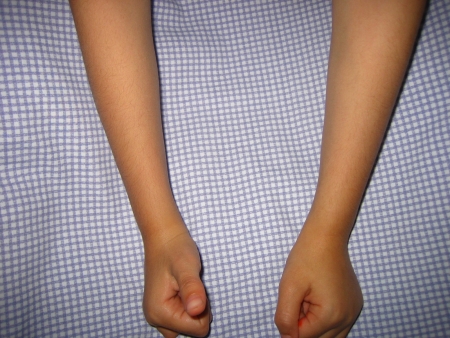How To Know If Your Child Has A Wrist Fracture
This is a two part series. This post will focus on how to check your child’s arm to see if there is a fracture while the next post on this topic will discuss a variety of homemade splints that you could create in seconds for your child’s injured arm.
**Its important to know that if you suspect that your child has seriously injured himself then you should have it checked out immediately. Don’t dismiss a possible fracture because it didn’t pass the fracture test below. If your child is in pain then consider having her checked out right away.**
How to check for a fracture
Check the arm for D.O.T.S
D-eformity
O-pen wounds
T-enderness
S-welling/Bruising
Deformity
The easiest way to tell if there is a fracture is to compare the two arms together. If one looks slightly deformed at the wrist (or elbow for an elbow fracture) then you would know if there is a possible fracture.


Examine the arms in the vertical position as well. If there is any deformity it will be easier to see from this angle.

DOTS could be performed for the legs as well. A sprained ankle will be clearly visible when comparing the two limbs in this position.
Tenderness
The second best way to check for a fracture, if there is no deformity, is to feel gently along the side of bone of the wrist. Feel on the top and the sides of the wrist/arm. If there is any pain at a specific point along the bone then it’s quite possible that there is a fracture. If not, it’s possible that it’s just a sprain. Since a sprain is an injury to the ligaments of a joint, a person with a sprain wouldn’t feel pain if you felt gently along the bone. Regardless, you would need to have it looked at by a doctor.
Bruising/Swelling
You should be able to quickly see if there is any swelling or bruising. Also, its very possible for bruising and swelling to be present even if there is no fracture.
My wife fell on her wrist while ice-skating in the winter and it looked terrible. It was bruised all over. However, there was no fracture but she still felt lots of pain. It even hurt her when the medics felt gently along the bone. In the end, she had to wear a wrist brace for at least six weeks and have repeated x-rays of her wrist. So not all injuries that pass the fracture test are indeed fractures.
As for open wounds, while they can exist at the site of the fracture this is uncommon. So really, you are looking for any deformity, bruising, or swelling and feeling for tenderness.
Regardless of the injury, you will want to apply ice. If it’s a possible fracture then first splint the injury and then apply ice.
Important Note
Do not apply the ice directly on the skin. Wrap the ice or cold compress before applying it to the site of injury. A plastic bag of ice needs to be wrapped as well. If the splinted injury is completely wrapped in a bandage then you could apply the ice directly to the bandage.
Do not apply for long periods. Apply cold for approximately 20 minutes on and 20 minutes off.
Do not apply heat. This will increase swelling.
No comments:
Post a Comment